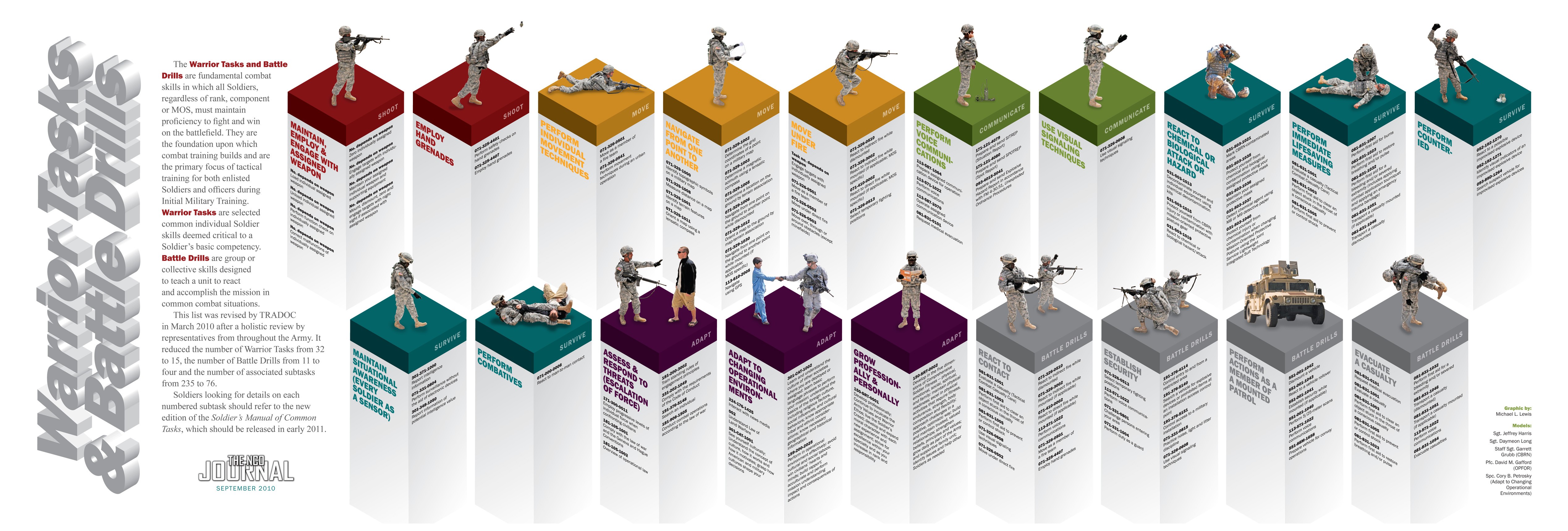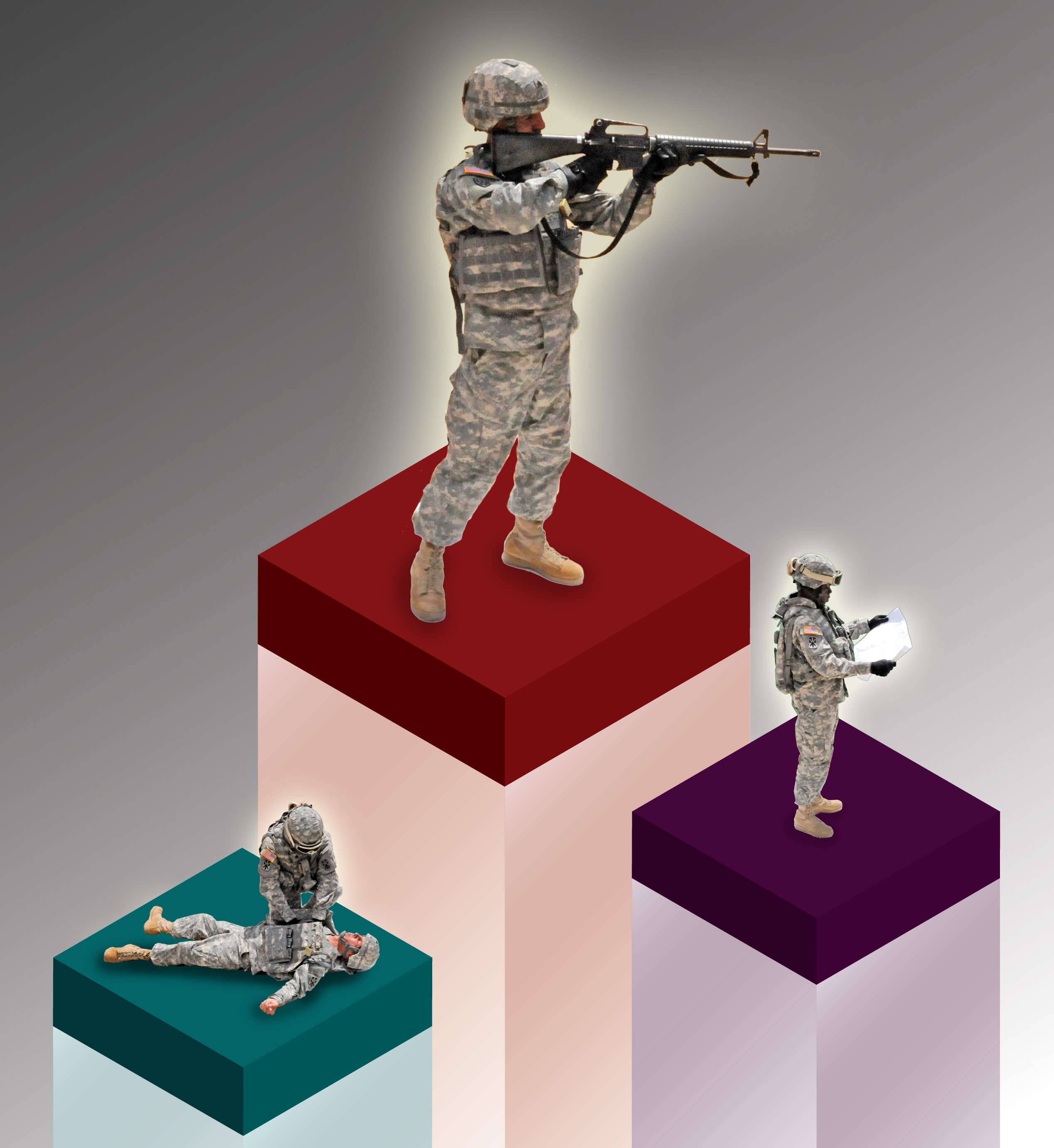The line comes right after the Warrior Ethos in the Soldier's Creed: "I am disciplined, physically and mentally tough, trained and proficient in my warrior tasks and drills."
In the very first days of basic training, Soldiers begin reciting these words, among the core tenets of what it means to be an American Soldier. Yet, despite being regarded as fundamental knowledge, most Soldiers couldn't explain what those "warrior tasks and drills" were - even at a conference organized last year specifically to discuss them, said Col. Craig Currey, former director of the Training Support and Schools Directorate at the Basic Training Center of Excellence, Fort Jackson, S.C.
"We asked Soldiers if they could define and tell what the Warrior Tasks and Battle Drills were. Everybody looked around the room; nobody could even come close," he said.
Rather than a lack of preparation, the issue was that there were simply too many tasks for anyone to possibly remember, much less become proficient in, said Lt. Gen. Mark Hertling, the deputy commanding general for Initial Military Training at the U.S. Army Training and Doctrine Command, Fort Monroe, Va.
"The Warrior Tasks and Battle Drills are the basis and the building blocks for everything that we do; they're the things we have to be proficient in. But, when you look behind what was in the old Warrior Tasks and Battle Drills, there were more than 200 associated subtasks with those. I don't think most trainers or most Soldiers could even tell you all of them. We had to determine if we were asking too much of our Soldiers and asking too much of our NCO trainers."
The process of overhauling the list - its first wholesale revision since it was originally released in 2003 - began last summer when a survey was sent out to more than 220,000 Soldiers to ascertain what knowledge the field considered essential.
"We asked what the most important skills our Soldiers needed to know," Hertling said. "We got about 38,000 responses that really outlined what the important things were and the things we were training that weren't so important. I think it was the first time we ever actually went to the 'customer' and asked, 'What do you need''"
The survey results were discussed at the aforementioned conference, held last October in Hampton, Va. Trainers from throughout the Army, including officers and NCOs from the reserve component, U.S. Forces Command units and basic training battalions, were invited to give their input.
"We literally went through not only all the Warrior Tasks and Drills in the first part of the week, but also what we were training in basic training versus what we should be training to accommodate the requirements and the mastery of skills that a Soldier needs in today's fight," Hertling said.
The old list had ballooned to epic proportions largely because it was continuously added to with tasks not necessarily fundamental to Soldiers in every military occupational specialty, said Lt. Col. Clinton Marquardt, who heads the TRADOC office responsible for developing the new Warrior Tasks and Battle Drills.
"The first critical thing we did was to take a holistic view of the list and ensure that the tasks applied to all Soldiers regardless of MOS or rank," Marquardt said. "Units before didn't even have the equipment to train all those tasks because they didn't apply to all Soldiers. Some of them were MOS-specific tasks that a cook or finance person wouldn't necessarily need to know."
Whittling down the list to its indispensable components was vital for it to remain relevant and easy to retain by young Soldiers, said Sgt. 1st Class Michael Johnston, the 2009 active component Army Drill Sergeant of the Year, who participated in the conference.
"The big thing was to take the list down in size and truthfully ask ourselves as a group, what does every Soldier in the Army need to know' That was really the big deal. It wasn't, what can we add. It was, what can we honestly say we don't need to have on this list."
The unwieldy old list was a hindrance, especially in basic training, said Staff Sgt. Joshua Marshall, the 2009 reserve component Drill Sergeant of the Year, who also took part in the new list's development.
"Because we were trying to get so many things in, we were giving privates information overload, and they weren't mastering anything. We tried to cut it down to the bare essentials of what really needed to be trained, making them experts in the things that were more important. A lot of what's in there now was in there before, but it's been streamlined and condensed, and broken down into easier categories so that people can better understand the tasks that fall underneath."
The revised list is far smaller and slashes the number of Warrior Tasks from 32 to 15, the number of Battle Drills from 11 to four and the number of associated subtasks from 235 to 76.
"Every Soldier in the Army, from private to general, is required to be proficient in these 15 [Warrior Tasks] and four [Battle Drills]. But, they're more usable now and encapsulate the things that we believe are what a Soldier, no kidding, needs to know," Currey said.
But, to reduce the list so drastically, some sacred cows had to be cut, he said.
"There was some argument. [Taking out] the Claymore mine, for example, generated some good discussion: 'This is the Claymore! Why are we taking that out'' Well, the reality is that almost nobody sees the Claymore mine except infantrymen, and the infantry teaches it in the first unit of assignment," he said.
"Some people wanted to keep crew-served weapons as a separate task," Marquardt said. "There was discussion whether that applied to all Soldiers. At the end, consensus was built, and it was recommended we remove the task."
The greatest reduction, however, resulted from eliminating scores of "critical" subtasks for myriad weapon systems and their attachments in favor of a handful of subtasks that depend on the specific weapon the Soldier is assigned.
"A Soldier may be in a unit that has the M4 [rifle], then three assignments later be in a unit that assigns a 9 mm [handgun]," Marquardt said. "Proficiency is now based on the unit they're assigned to and the unit equipment they're assigned."
"Originally, they listed every single weapons system and listed every single type of laser," Johnston said. "Somebody suggested, instead of mentioning a particular weapons system, just say, whatever weapons system, attachments, optics or lasers your Soldier is assigned is what he or she will be qualified on and, of course, proficient in. As an infantry guy, I always want to have the heavy weapons to be in there. But, again, I've got to ask myself, does every Soldier need to know how to use a .50-cal [machine gun]' Does every Soldier need to know how to use a Mk 19 [grenade launcher]' As an infantry guy, I say yes. As a Soldier, I say no."
While the list of Warrior Tasks and Battle Drills has been finalized and Soldiers can now begin learning and training on them and their associated subtasks, several new subtasks are in the process of being written, Marquardt said.
"The majority of the tasks that were selected as the critical supporting tasks on the new list already existed as individual, Level 10 Soldier tasks. But, there are several of them that do not yet exist anywhere. So, the proponents for those Warrior Tasks are responsible for writing the subtasks and the associated tasks, conditions and standards. We're expecting that in the first quarter of 2011, we'll get those back," Marquardt said. He advises that units begin training the existing subtasks while awaiting the new ones to be collated and disseminated in a new version of the Soldier's Manual of Common Tasks.
"We'll look at the list again, probably within a couple of years just to get an azimuth check," he added. "It won't be another total rewrite because this review was pretty in-depth. We've got to get it incorporated in the field before we start making big changes again."
Currey said the reaction regarding the new list, which was distributed Armywide in March, has been overwhelmingly positive.
"People are happy. Simplifying things doesn't always necessarily make things better. But, in this particular case, I think it did," he said.
"It's getting back to the fundamentals of training - what's critical for Soldiers," Marquardt said. "It's manageable so that Soldiers have a reasonable expectation of learning what they should know. Soldiers can now look at the list and say, 'I understand why that task is critical.'"
Marshall agreed. "The new way it's laid out is just excellent. And, that's a result of many people working together on it. It wasn't just a bunch of officers up at TRADOC who said, 'We're going to revise this.' They pulled in drill sergeants, company commanders, company first sergeants, senior NCOs and even some junior Soldiers. I honestly think the changes that are there are because NCOs stood up and gave their input, and a lot of officers really listened to what we had to say."
Printable PDF version of this story, including fold-out poster available <a href="https://usasma.bliss.army.mil/NCOJournal/Archives/2010/September/PDFs/Tr-WTBD-Sep.pdf">HERE</a>
- - -
To contact Michael L. Lewis, e-mail <a href="mailto:michael.lewis73@us.army.mil">michael.lewis73@us.army.mil</a>.






Social Sharing